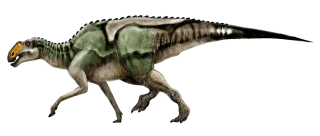Gryposaurus monumentensis

Name: Gryposaurus monumentensis
(Pronunciation: GRIP-oh-SORE-us MAHN-you-men-TEN-siss)
Age: Late Cretaceous (~76 million years ago)
Where It's Found in Utah: Kane and Garfield counties, Grand Staircase-Escalante National Monument, Utah.
Geologic Formation: Kaiparowits Formation (middle unit)
Classification: Ornithischia – Ornithopoda – Hadrosauridae - Hadrosaurinae
Description: Hadrosaurids are often referred to as “duck-billed” dinosaurs because the front of their skull resembles a bill of a duck. Even the name Gryposaurus means “hooked beak lizard.” “Monumentensis” gives credit to Grand Staircase-Escalante National Monument in southern Utah where these animals were found. There are two types of hadrosaurs: those without crests, such as Gryposaurus monumentensis, and those with crests on top of their heads, called lambeosaurines. Gryposaurus monumentensis is unique compared with other species of Gryposaurus in that it the front part of the “beak” rises at a steeper angle. Three to four species of Gryposaurus have been found with a range from as far north as Alberta, Canada, to as far south as Texas, making Gryposaurus the genera with one of the largest geographical ranges. Gryposaurus was a very large duck-billed dinosaur – easily reaching the same size as Tyrannosaurus rex.
Why It’s a Top NHMU Dinosaur: Gryposaurus monumentensis was probably the largest dinosaur in Utah’s Late Cretaceous ecosystem reaching 40 feet (12 meters) in length. NMHU paleontologists published the paper naming this new dinosaur in 2007. Emphasizing its massively built skull and skeleton, NMHU paleontologist Scott Sampson referred to it as the “Arnold Schwarznegger of duck-billed dinosaurs.” Like other hadrosaurs, Gryposaurus monumentensis was a common and very successful herbivore . At any given time, this dinosaur had over 300 teeth available to slice up plant material. Inside its jaw bone, there were numerous replacement teeth waiting, meaning this Gryposaur may have carried more than 800 teeth! These animals were facultative quadrupeds, which means that they could walk on either four limbs or just their two hind limbs. Paleontologists think they spent most of the time on four legs, sometimes standing on two legs to reach for vegetation. Paleontologists also believe hadrosaurs may have lived in herds like some modern mammals. They also appear to have been caring parents. Evidence from Montana and Canada suggests hadrosaurs nested in colonies and may have taken care of their young.
Where Can I See It?: The Past Worlds Gallery at the Natural History Museum of Utah.
Suggested Reading/References:
Gates, T. A., and S. D. Sampson. 2007. A new species of Gryposaurus (Dinosauria: Hadrosauridae) from the late Campanian Kaiparowits Formation, southern Utah, USA. Zoological Journal of the Linnean Society 151:351-376.
Lambe, L. M. 1914. On Gryposaurus notabilis, a new genus and species of trachodont dinosaur from the Belly River Formation of Alberta, with a description of the skull of Chasmosaurus belli. Ottawa Naturalist 27:145-155.
Prieto-Márquez, A. 2010. The braincase and skull roof of Gryposaurus notabilis (Dinosauria, Hadrosauridae) with a taxonomic revision of the genus. Journal of Vertebrate Paleontology 30:838-854.
Credits:
Image: © Victor Leshyk
Author: Carolyn Levitt, Paleontology Graduate Student at the Natural History Musuem of Utah (2012)